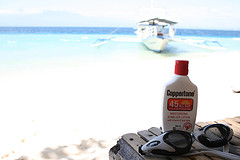
 The Food and Drug Administration (FDA) is working on new rules for sunscreens. That means safer products for us! So far, they’ve proposed three things: capping SPF numbers at 50+, banning certain terms in labeling, and requiring UVA testing and labeling. The rules won’t be finalized and released until later this year, but we wanted to let you know now, so you can get a head start on choosing products that truly protect your skin.
The Food and Drug Administration (FDA) is working on new rules for sunscreens. That means safer products for us! So far, they’ve proposed three things: capping SPF numbers at 50+, banning certain terms in labeling, and requiring UVA testing and labeling. The rules won’t be finalized and released until later this year, but we wanted to let you know now, so you can get a head start on choosing products that truly protect your skin.
Why the SPF cap? To avoid misleading customers. SPF stands for “sun protection factor,” and specifically refers to how long the product protects your skin from being reddened or burned by UVB rays. An SPF of 15 filters out about 93 percent of UVB rays, 30/97 percent, and 50/98 percent, but after that, the increases are negligible. Of course, manufacturers love to get those numbers higher and higher. If they can boast a bigger number than their competitors, they’ll make more money. Most consumers don’t understand SPF, so they often shell out more money for a number that’s not worth the investment. The new cap will help prevent that. (We recommend you use a chemical-free sunscreen with an SPF of at least 30 to lower your risk of skin cancer, but you don’t need to go higher than 50.)
As to the other labeling changes, here’s a sneak peak. First, “Sun Protection Factor” is going to be changed to “Sunburn Protection Factor,” to more clearly communicate what SPF means-protection from sunburn, not from the sun as a whole. Products will no longer be able to use the word “sunblock,” as nothing blocks the sun’s rays entirely. Water-resistant terminology will also be more carefully limited. Products will no longer be able to claim “waterproof,” and must retain their SPF after 40 or 80 minutes’ immersion in water to be labeled “water resistant” or “very water resistant.”
Finally, the UVA question. This is the most exciting part about the new rules, and the part we’ve needed for years, now. Nothing in our current labeling requirements says anything about UVA protection, but UVA rays-which penetrate more deeply into the skin than UVB-are considered by many experts the more dangerous of the sun’s rays. They won’t cause skin to burn, but they do cause wrinkles and premature aging. Research has shown that they can cause DNA damage, and may be the more cunning culprits when it comes to skin cancer.
Some of our current sunscreen products contain UVA protection (they’ll describe it as “broad spectrum” on the label, or simply “UVA/UVB”), but there has been no standardized testing to help us, as consumers, compare. For example, if you’re standing in the store looking at two products, both of equal SPF, and both say “broad spectrum sun protection,” which one do you choose? The new rules would use a 1-4 rating system to help you determine that, with “4” reflecting the highest UVA protection.
All this is forthcoming. What can you do now to choose a product that really works? First of all, look for the UVA terms mentioned above (broad-spectrum, UVA/UVB), and check the ingredient deck for items like titanium dioxide and zinc oxide, which will protect your skin from all rays. Ignore claims of water resistance and “all-day protection,” and get in the habit of reapplying your sunscreen every couple hours, when you sweat, and when you get wet. As always, don’t rely entirely on sunscreen-wear protective clothing, and avoid high intensity sunlight hours (10:00 a.m. to 3:00 p.m.). Finally, the Environmental Working Group (EWG) has published several handy lists of effective sunscreens, including those for the beach and sports, lip balms, daily moisturizers, and makeup products. Check them out before your next purchase.
Do you have a great broad-spectrum sunscreen to recommend? Please share with us.
Photo courtesy of dee225 via Flickr.com.

